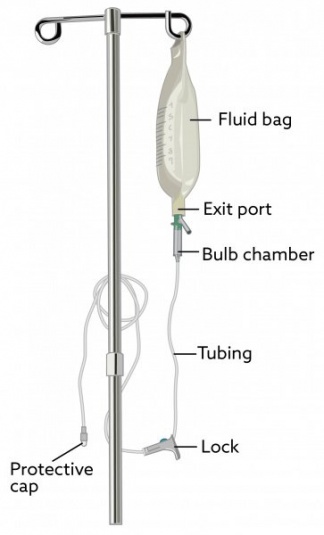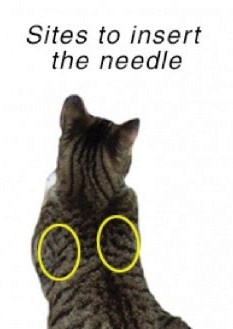Subcutaneous Fluid Administration
Administration of supplemental fluids can benefit cats with a variety of medical conditions. Most commonly, this is recommended for cats with chronic kidney disease (CKD). We recommend that you learn this technique for your cat. Don’t be alarmed - it is normal to feel reluctance about administering any treatment involving injections to your pet. Giving injections is outside the comfort zone for almost anyone outside the medical profession. However, subcutaneous fluid administration is not nearly as difficult as it sounds. The benefits provided to your cat will make it well worth your time to learn this simple technique.
What equipment is involved?
The equipment consists of a bag of fluids, a fluid drip set, and a needle. The fluid drip set is simply a tube that connects the fluid bag to the needle. You will eventually become comfortable with the steps involved.

|
How is the needle inserted?
Insert the needle just under the skin in one of several locations that have unusually loose skin. Typically this is the easiest at the level of the shoulder blades, just to the right and to the left of the midline.
What is the correct technique?

The following is a list of steps to help you administer the fluids safely and accurately.
- Choose a location where you will treat your cat. This may be on a table, countertop, or on your lap.
- Hang the fluid bag about 3 feet (1 meter) above the level of your cat’s head.
- Place your cat in the treatment location. Be sure that both of you are in a position that will be comfortable for about 10 – 15 minutes. The end of the fluid set should easily reach your cat.
- Pick up a roll of loose skin in one of the locations noted on the image.
- Lay the point of the needle at the base of the roll of skin with the needle horizontal and pointing to the cat’s head, assuming the cat is lying in an upright position.
- Advance the needle slightly forward while pulling the roll of skin backward. That should place the point of the needle under the skin.
- Release the roll of skin. The point of the needle should remain under the skin.
- Grasp the fluid set lock in one hand. Begin the flow of fluids by rolling the roller upwards.
NOTE: Some cats are more cooperative if they are placed in a box not much larger that the cat. A cardboard cat carrier is often the correct size. Alternatively, some cats respond well to being held in a towel that covers their head during the procedure. Experiment with different locations and techniques until you find the most comfortable technique for you and your cat. Always reward your cat after the procedure with a tasty treat.
How much fluid should I give each time?
The instructions at the end of this handout tell how much to give for your specific situation. As a rule, the average cat should receive 100 – 150 ml of fluids at one time. When you have given the prescribed amount, complete the following steps:
- Stop the flow of fluids by rolling the roller in the fluid lock set downward firmly.
- If you do not close it well and the bag is left hanging, fluid will drip out. Remove the needle from the skin and replace its protective cap.
- PLACE A NEW STERILE NEEDLE ON THE DROP SET AS SOON AS YOU ARE THROUGH. This keeps bacteria that were picked up on the old needle from migrating into the fluid. Disposal information for used needles is listed below.
- Store the equipment in a safe place until the next fluid administration.
Hazardous Waste Disposal Sites
Disposal of syringes and needles in King County
Disposal of syringes and needles in Pierce County
What about warming the fluid?
Warming the fluids above room temperature before administration is a nice way to improve the comfort of the experience for your cat. A safe way to do this is to simply place the fluid bag into a bowl of hot tap water for a 10 – 15 minute period prior to administration. You should always test the temp of the fluid on your skin to make sure that it is not too warm prior to placing the needle under your cat’s skin. This needs to be done carefully, without compromising the sterility of the needle.
WARNING: Do not, under any circumstances, warm the fluids in a microwave oven.
What if the fluid stop running during administration?
This often happens when the end of the needle moves against the skin or the underlying tissue. Do not remove the needle; rather, gently reposition it until the fluids begin to flow again. Experiment with the needle’s position until the fluids flow freely. Twisting the needle will change the position of the bevel. This may be all that is needed.
What if the fluid runs slowly on subsequent treatments?
When you are finishing giving fluids, you should close the lock firmly. This may crush the tubing so that fluid will not flow well on subsequent use. If this happen, move the lock to another place on the fluid tubing, and open the crushed area of the tube by pinching it with your fingers.
What if the fluid become cloudy in appearance?
If any cloudiness or discoloration occurs, do not use the bag. It usually means that the fluids have become contaminated with bacteria. If you administer these fluids to your cat, a serious infection may occur under the skin.
What other tips do I need to know?
It is not necessary to “sterilize” the skin with alcohol before inserting the needle. In reality, wiping a little alcohol on the skin does not sterilize it and the odor and feel of the alcohol may aggravate your cat.
Most cats tolerate fluid administration quite well. However, if the fluids are unusually cold or hot, they may be uncomfortable. Ideally, they should be administered at about body temperature. However, as long as they are at room temperature most cats do fine. Do not refrigerate them.
As the fluids are running, a lump will form under the skin. Do not be alarmed; this is the pocket of fluids that will be absorbed over several hours. If absorption is slow, gravity may cause the fluids to migrate downward. They could move under the skin of the front or rear legs. However, if this happens, they will still be absorbed.
There is no problem if a few bubbles of air are injected under the skin. If quite a bit of air gets under the skin, you may feel a crackling sound when you push on the skin and your cat may experience mild discomfort for a couple of hours, but no real harm will occur. The body will eventually absorb the air.
What about Additives to fluids?
In some cases, our veterinarian will place additives to your fluids specifically needed by your cat. Typically, these will be additional potassium (KCI), B-Vitamins, or sometimes both. These additives will be marked and dated on the outside of the fluid bag. Fluids with additives should be administered only as directed.
